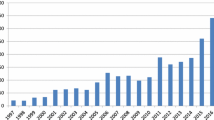Abstract
Soft computing triggers a revolutionary change in the field of computer science and technology. How did soft computing evolve? What is soft computing application situation? Which fields are soft computing widely used? Which fields does soft computing still need popularizing? All of these problems resort to the survey on the development of soft computing.
Similar content being viewed by others
Notes
“Lotfi A. Zadeh. Creator of Fuzzy Logic,” Interview by Betty Blair 1994 Azerbaijan International Winter 1994 (2.4).
References
Banerjee M, Pal K (2002) Rough fuzzy MLP: knowledge encoding and classification. IEEE Trans Neural Netw 9:1203–1216
Buffa G, Fratini L (2012) Mechanical and microstructural properties prediction by artificial neural networks in FSW processes of dual phase titanium alloys. J Manuf Processes 14:289–296
Cao Y et al (2006) Fault—tolerant neural network fault diagnosis system based on rough set. Comput Eng Des 27(4):637–639
Choobi MS, Haghpanahi M (2012) Prediction of welding-induced angular distortions in thin butt-welded plates using artificial neural networks. Comput Materi Sci 62:152–159
Deng Y (2012) Research on reservoir parameter prediction method based on rough set-support vector machine. China university of geosciences, Beijing
Ding Y et al (2001) Computing and soft computing. J Syst Simul 13:198–203
Jiang D et al (2002) Research and development of intelligent fault diagnosis. Ordnance Autom 21(2):12–15
Li W (2005) Magnesium and magnesium alloys. Central Couth University Press, Changsha
Niskanen VA (2004) Soft computing methods in human sciences. Springer, Berlin, p 1
Song H (2017) Research on application of some soft computing approaches for intrusion detection in the big data environment. Wireless Internet Technol 15:111–112
Tang X et al (2004) Application research of variable clustering method in data mining. Comput Eng Appl 40(24):171–173
Wang F et al (2003) An overview of intelligent fault diagnosis techniques. Mach Tool Hydraul 4:6–8
Yang L et al (2012) Oil and gas reserve value grade evaluation based on support vector machine. J China Univ Petrol 36(3):192–196
Zadeh LA (1965) Fuzzy sets inform. Control 8:338–353
Zadeh LA (1984) Making computers think like people. IEEE Spectr 8:26–32
Zadeh LA (1992) Fuzzy logic, neural network, and soft computing, one-page course announcement of CS 194-4, Spring 1993. The University of California, Berkeley, p 1
Zadeh LA (1994) Soft computing and fuzzy logic. IEEE Softw 6:48
Zadeh LA (2008) Toward human level machine intelligence—is it achievable? The need for a paradigm shift. IEEE Comput Intell Mag 8:11–22
Zhang Q et al (2010) Based on the evolution of god through the network of oil and gas layer research. Inf Technol 9(6):25–27
Acknowledgements
Work leading to this paper was partially supported by the Major Projects for National Philosophy and Social Sciences Foundation (China). This study was funded by the Major Projects for National Philosophy and Social Sciences Foundation (China). The grant number is ‘17ZDA029.’
Author information
Authors and Affiliations
Corresponding author
Ethics declarations
Conflict of interest
He Tian-ping has received research grants from National Office for Philosophy and Social Sciences (CN). The authors declare that they have no conflict of interest.
Ethical approval
This article does not contain any studies with human participants performed by any of the authors.
Additional information
Communicated by A. Di Nola.
Publisher's Note
Springer Nature remains neutral with regard to jurisdictional claims in published maps and institutional affiliations.
Rights and permissions
About this article
Cite this article
Liang, Y., He, Tp. Survey on soft computing. Soft Comput 24, 761–770 (2020). https://doi.org/10.1007/s00500-019-04508-z
Published:
Issue Date:
DOI: https://doi.org/10.1007/s00500-019-04508-z




